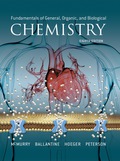
Concept explainers
What class of enzymes catalyzes the majority of the reactions involved in carbohydrate digestion?
Interpretation:
To determine which class of enzyme catalyses the majority of the reaction involved in carbohydrate digestion.
Concept Introduction:
Enzyme: This is highly specific both in the reactions that they catalyse and their choice of reactants, which are called substrates, enzymes usually catalyses a single chemical reaction (or) a set of closely related reactions.
Answer to Problem 22.22UKC
Hydrolases enzyme catalyses the majority of the reactions involved in carbohydrate digestion.
Explanation of Solution
Hydrolases enzyme process:
- 1. These enzymes catalyse cleavage reaction or the reverse fragment condensations.
- 2. According to type of bond cleaved, a distinction is made peptidase, esterase, lipases, glycosidase, phosphatase so on.
- 3. The some class of enzyme include cholesterol, alkaline phosphate and glucoamylase.
There are three types of enzymes that are needed in digestion, one for each of main energy sources for your body. Carbohydrates are broken down by the enzyme amylase.
Hydrolases enzyme catalyses the majority of the reaction involved in carbohydrate digestion.
Want to see more full solutions like this?
Chapter 22 Solutions
EBK FUNDAMENTALS OF GENERAL, ORGANIC, A
- Calculate pH of a solution prepared by dissolving 1.60g of sodium acetate, in 88.5 mL of 0.10 M acetic acid. Assume the volume change upon dissolving the sodium acetate is negligible. Ka is 1.75 x 10^-5arrow_forwardShow a mechanism that leads to the opening of the ring below under acid-catalyzed conditions. Give the correct Fischer projection for this sugar.arrow_forwardWhat is the stereochemical relationship between B & C?arrow_forward
- Don't use ai or any chat gpt will dislike okk just use accurate information okkk okkk just solve full accurate. don't use guidelines okk just did it accurate 100% sure experts solve it correct complete solutions okkk follow all instructions requirements okkkarrow_forwardhow would you make this plot in excel?arrow_forwardwhat is the productarrow_forward
- Balance the following equation and list of coefficients in order from left to right. SF4+H2O+—-> H2SO3+HFarrow_forwardProblem 15 of 15 Submit Using the following reaction data points, construct Lineweaver-Burk plots for an enzyme with and without an inhibitor by dragging the points to their relevant coordinates on the graph and drawing a line of best fit. Using the information from this plot, determine the type of inhibitor present. 1 mM-1 1 s mM -1 [S]' V' with 10 μg per 20 54 10 36 20 5 27 2.5 23 1.25 20 Answer: |||arrow_forward12:33 CO Problem 4 of 15 4G 54% Done On the following Lineweaver-Burk -1 plot, identify the by dragging the Km point to the appropriate value. 1/V 40 35- 30- 25 20 15 10- T Км -15 10 -5 0 5 ||| 10 15 №20 25 25 30 1/[S] Г powered by desmosarrow_forward
 Human Physiology: From Cells to Systems (MindTap ...BiologyISBN:9781285866932Author:Lauralee SherwoodPublisher:Cengage Learning
Human Physiology: From Cells to Systems (MindTap ...BiologyISBN:9781285866932Author:Lauralee SherwoodPublisher:Cengage Learning Human Biology (MindTap Course List)BiologyISBN:9781305112100Author:Cecie Starr, Beverly McMillanPublisher:Cengage Learning
Human Biology (MindTap Course List)BiologyISBN:9781305112100Author:Cecie Starr, Beverly McMillanPublisher:Cengage Learning





